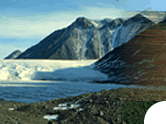Global Litter Invertebrate
Decomposition Experiment
Rocky Harbour, Canada
Site Manager
Dr.
Stephen Flemming
Ecosystem Scientist
Gros Morne National Park
Rocky Harbour, NF
A0K 4N0
Canada
Telephone: (+1) 709 458 3577
Site Description
The GLIDE site is located on the Great Northern Peninsula
of the Island of Newfoundland, along the eastern shore of
the Eastern Arm of Bonne Bay, within Gros Morne National
Park of Canada (the full official name of the park, established
1973). The site was laid out in a second-growth balsam fir-white
birch forest with an estimated average tree age of about
50 years. The understory is fairly open because of the shade
of the trees and moose browsing. The moose population is
very high in the park area (the park has an area of 1,805
square kilometres and a moose population between 8,000 and
8,500). Moose were introduced to the Island of Newfoundland
about 100 years ago, and feed heavily on balsam fir boughs
in winter, and to a smaller extent in summer. Moose movement
through the site had to be considered in the placement of
the bags.
Site Location
Site location is 49° 32' 35" latitude and 58° 49'
50" longitude.
Site
Area
The litterbags are located on a site with an area of about
2 hectares.
Site
Elevation
Site elevation is 50.0 m.
Annual Rainfall
Average annual precipitation is around 1,500 mm.
Annual Temperature
Average annual temperature based on 30-yr normals is 4.2°C.
Soil
Soil classification is Podzol (more specifically Podzol/Gleysol,
Gleyed Humo-Ferric Podzol, Orthic Humic Podzol, and Orthic
Cleysol).
Native
Forest/Vegetation Types
Native forest and vegetation type is second-growth balsam
fir-white birch forest. Dominant tree species are Abiebals,
Betupapy, and Piceglau. Stand density is 6271
trees/ha, and basal area is 18.2 m2/ha. The ecoclimatic
province of this site is boreal; dominant shrub species
are Acerspic and Taxucana. Dominant moss
species are Hylosple, Pleuschr and Diacmaju. Dominant
herb species are Corncana, Triebore and Gaulhisp.
Principal
Biome/Ecoregion
Hodridge life zone is cool temperate subalpine wet forest.
Prinicpal biome is Boreal Forest, Western Newfoundland
Ecoregion.
|
